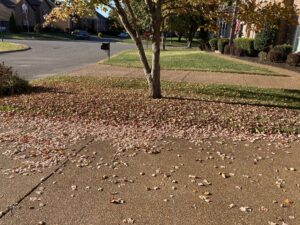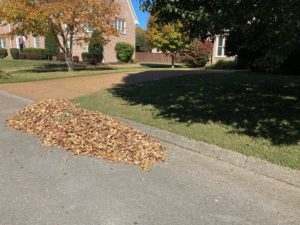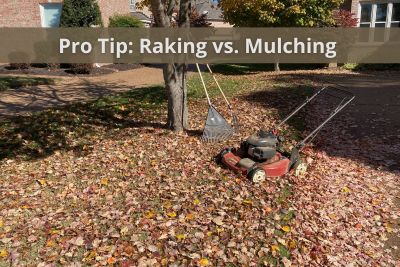As Autumn leaves fall, homeowners are faced with an annual question: do I rake tree leaves off of my grass and dispose of them or do I simply cut them up with my lawnmower and leave them on the lawn?
It turns out that leaves are an excellent natural resource to help develop a thick, healthy lawn.
“It returns nutrients back to the grass,” said John Sorochan, Ph.D. Distinguished Professor of Turfgrass Science at the University of Tennessee in Knoxville. “It adds valuable organic matter to make a healthier soil.”
There’s research to prove it.
“About 10+ years ago, one of our researchers evaluated the benefits of leaf mulch to a lawn,” said Ryan Bearss, Research Assistant in the Rogers Lab at Michigan State University. “His research found that it is indeed most advantageous to mow/mulch leaves in the fall.”
“It’s a source of nitrogen and organic compounds contained within the leaves that get recycled back into the soil, which is promoting healthier turf. The research indicated a benefit of mulched leaves to lawns, improved spring green-up.”
The experts advise setting your lawnmower deck as high as it will go and start cutting. What you want to do is cut the leaves into small enough pieces that they will sift into the turf canopy — between the top of the grass and the surface of the soil.
“You might have to go over it twice with the mulcher to get it in, break it down, chop it up, but as long as it gets it into the canopy that’s the best thing you could be doing for your lawn,” Sorochan said.
Once the leaves are ground up and in the canopy, microbes then take over and start the decomposition process, much the way winterizing fertilizer works.
“Microbes like to feed on organic matter as it’s breaking down, but the bigger thing is releasing the nutrients back,” Sorochan said.
“You mow them up, it breaks them down, it’s in the soil, done,” Bearss said.
The Michigan State researchers found that homeowners who mulched their leaves year after year reduce the amount of fertilizer needed to get a thick, green lawn in the spring.
“The best lawnmowers to use for this are the ones that have the actual mulching blades that kind of suck it up and just return the clippings down so it doesn’t shoot it out the side or the back,” Sorochan said. “It’s just going straight down.”
Once you’re done running the lawnmower over the leaves, take a look at the lawn to make sure you don’t need to go over it again.
“You want at least half of the grass still being exposed afterwards, half to three quarters of it being able to be exposed after you mulch the leaves,” Sorochan advises.
The more grass you see, the faster the leaf bits will decompose.
The researchers noticed something else: mulched leaves suppress weedy populations, particularly dandelion, from germinating in the spring.
 “As a home lawn enthusiast myself, I think one of the most pertinent pieces of this research to a practical application for homeowners are the leaves of tree species most effective at doing this — maple and oak,” Bearss pointed out. “We also have shading of the weeds similar to how mulch might work in a garden bed; it crowds out weeds and also uses nitrogen or uses resources that the weeds would otherwise use to germinate.”
“As a home lawn enthusiast myself, I think one of the most pertinent pieces of this research to a practical application for homeowners are the leaves of tree species most effective at doing this — maple and oak,” Bearss pointed out. “We also have shading of the weeds similar to how mulch might work in a garden bed; it crowds out weeds and also uses nitrogen or uses resources that the weeds would otherwise use to germinate.”
“More to the point, homeowners can save themselves work by simply mulching rather than taking and bagging their leaves.”
One thing is certain: it is never a good idea to leave fall foliage on your lawn all winter. When leaves become wet they create a dense blanket that keeps sunlight and oxygen from reaching the grass and soil, which eventually will weaken the stems and roots. Additionally, decomposing leaves would turn your lawn into a petri dish of fungal diseases.
“From a turfgrass perspective, if you don’t rake your leaves you’re not allowing any air circulation, no sunlight from getting through,” Bearss said. “The key is to maximize light penetration into the turfgrass canopy while handling any organic material on the top of the grass to reduce the infection or spread of disease.”
“And with all that moisture trapped in piles of leaves, it spells trouble for things like snow mold the following spring.”
The big takeaway, according to Sorochan, is that there really is no denying the benefits of mulching vs. raking.
“There should not be a debate, no. In a home lawn situation the best thing you can do is mulch leaves into your grass. It’s going to be healthy for your lawn.”
[Click here to read a transcript of our interview with turfgrass specialist John Sorochan]

